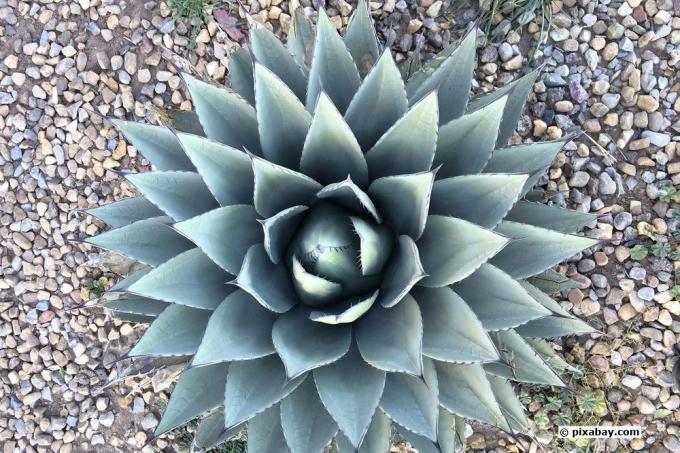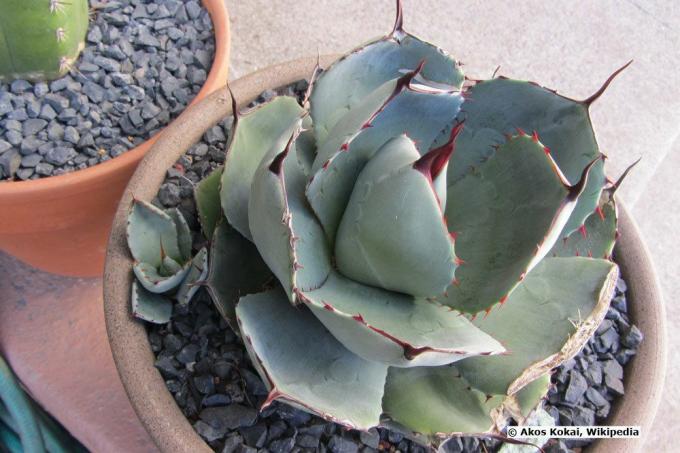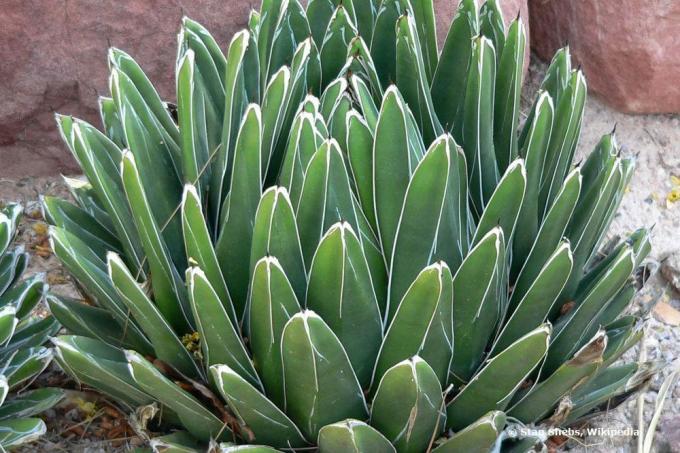
table of contents
- origin
- wintering
- Hardiness
- In the bucket
- Winter location
- measures
- Cold protection
- Winter care
Agaves often impress with their mighty rosettes of leaves, which the plants use to store water. After all, they live in dry and hot regions where water is in short supply. In this country it rains often enough, especially in autumn and winter, that the plants have plenty of water available. And that's exactly what the desert dwellers have a problem with. Because they do not tolerate rain very well. Therefore, especially hardy agaves must be protected from moisture during the cold and rainy season.
origin
Botanical assignment and origin
Agaves originally come from the American continent. Their natural range extends from the south of the USA through Central America to Colombia and Venezuela. The Caribbean is also the natural home of the agave. Biodiversity is greatest in the Mexican states of Hidalgo, Puebla and Oaxaca. Today they are cultivated worldwide and are naturalized in countries with tropical, subtropical and frost-free climates.
From a botanical point of view, agaves form the genus Agave of the subfamily Agavoideae (agave plants), which in turn belongs to the asparagus family (Asparagaceae). The genus Agave is divided into three sub-genera, in which species and groups are summarized. According to the botanical system, there are a large number of agave species. There are also a number of hybrid plants.
wintering
Despite the variety of agave species, only a few varieties are hardy due to their natural origins. As far as winter hardiness is concerned, agaves can be used according to their cold or cold weather. Frost resistance can be classified. The specified temperatures are guide values, and the list does not claim to be complete.
Hardiness
Temperatures from minus 20 resp. tolerate almost minus 25 degrees Celsius:
- Agave toumeyana ssp. Bella
- Agave havardiana
- Agave utahensis

Tolerate temperatures between minus 12 and minus 18 degrees Celsius:
- Agave ovatifolia
- Agave lechuguilla
- Agave parryi var cousei
- Agave havardiana

Tolerate temperatures down to minus 10 degrees:
- Agave schidigera
- Agave victoriae-reginae
- Agave montana x gracilipes
- Agave leopoldii

These hardy varieties can tolerate low temperatures, but these specimens rarely survive permafrost. Therefore, planting out is only recommended in the milder regions, such as the wine-growing areas. Cultivated as a container plant, however, these varieties are quite capable of surviving the German winter in other regions if they are helped.

Tip: When buying it, ask the nursery whether the plant has already overwintered outdoors. If so, then it is better used and hardened to the German winters than plants that have overwintered in a cold house or similar.
In the bucket
Winter in the bucket
Since agaves are native to dry areas, moisture is the biggest problem for the desert dwellers, because it causes the plants, more precisely their roots, to rot. In order for agaves to get through the winter well, they must above all be protected from moisture.

Winter location
Choose a sheltered spot for the agave's winter location. All forms of roofs, canopies or eaves are suitable for this. The main thing is that it does not get wet from the rain and that water cannot collect in the leaf rosettes.
Tip: Put the agave in its winter location in late summer. So she can get used to the cold season.
If no roof is available, the agave can also be "artificially" roofed over. Make sure that there is enough air circulation under the roof. If the roof is installed too low, moisture builds up, which can also lead to rot. In addition, the tinkered roof should be translucent.

Tip: Good air circulation is particularly important when using a foil cover.
The ideal winter location also protects agaves from the cold. If you have the choice, place the plants on a south wall of the building or terrace.

measures
Further measures against moisture
When it rains heavily, a roof is often insufficient protection for the plants. In addition, there is the increased humidity, which quickly sets in in this country in fog or continuous rain. To counteract these sources of moisture, a drainage layer in the pot or bucket is a good idea.

For drainage, give:
- Put gravel or potsherds as the bottom layer of the planter
- Mix the gravel with sand if necessary
Tip: Drainage not only helps against waterlogging in winter, it is also a proven means of avoiding waterlogging in summer.
However, the best drainage layer in the planter is of no use if the container has no drainage holes. Only plant agaves in containers with drainage holes so that the water can drain away. Of course, this also applies to coasters. No water should remain there either.
Tip: If water has accumulated in the coaster despite the holes, simply empty it out.

Cold protection
Cold and wet from below
Moisture and cold, especially in winter, like to creep up from the floor into pots or buckets. Your loopholes are the drainage holes that are important to avoid waterlogging. In order to ward off the cold and moisture, a small distance between the ground and the planter is sufficient. Coasters.

For example, set up the agave:
- a styrofoam sheet
- on a trivet or pot with small feet, no rollers
Winter care
Once the right location has been found and the agave is protected from moisture, it does not need any further care. It does not have to be fertilized or watered. The latter in particular would even be counterproductive.


